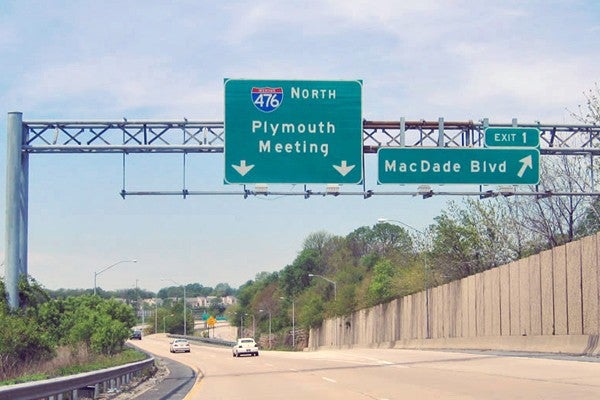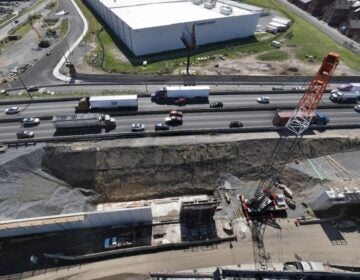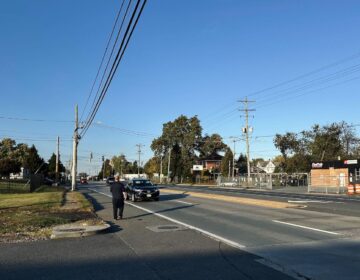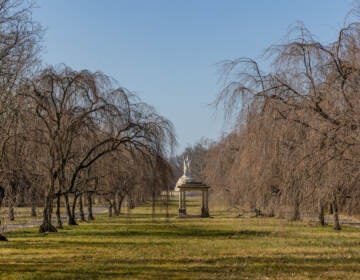Why is the Blue Route called the Blue Route?

Interstate 476 (Photo courtesy of Pahighways.com)
That was the color used to mark this route on the 1950s maps that showed three possible routes for the highway that became Interstate 476.
The official name of the highway that bisects the western suburbs from Chester to Plymouth Meeting used to be the Mid-County Expressway. No one calls it that. Now, it’s officially Veterans Memorial Highway. No one calls it that. Its number is Interstate 476. If someone calls it that, you know they’re not from around here, or moved here recently.
Anybody who grew up around here calls the highway the “Blue Route.”
When visitors ask for directions, natives will, without thinking twice, direct them to take the Blue Route. Yet no sign anywhere on the highway uses the term. Shadow Traffic calls the road the Blue Route on its rush-hour reports. At the beginning of The Sixth Sense, you hear such a traffic report refer to the Blue Route.
The building of Interstate 476, and the choosing of the “blue route” that roughly tracked the paths of Crum and Darby creeks through Delaware County, was a multi-decade saga of contention and delay. The notion of a highway roughly along its present-day route dates to 1929. Serious planning began almost as soon as President Eisenhower inked the Federal Aid Highway Act in 1956, ushering in the interstate system.According to www.pahighways.com, the then-Pennsylvania Department of Highways sketched three possible routes for a highway connecting Philadelphia’s western suburbs. The eastern route was alternatively called the Red or Yellow Route. The western route was the Green Route. The Blue Route split the difference.
Highway engineers concluded the Blue Route would provide the best flow of north-south traffic while doing the least damage to populous areas.
If they thought that meant the Blue Route would sail through, they were terribly bad prophets. Public hearings on the Blue Route began in 1961, with a thought to begin building the road in 1964. In the mid-’60s, PennDOT was still predicting a 1971 completion. Nice try. Environmental and quality-of-life objections from suburban communities held up building of the highway repeatedly.
A couple of orphaned chunks of hte 21.5-mile highway were completed in the 1970s, with only the section near Plymouth Meeting seeing actual traffic. The others were expensive bike and walking paths for Delaware County residents until 1991, when the Blue Route finally opened on its full route from Interstate 95 near Chester to the Norristown-Northeast Extension exchange of the Pennsylvania Turnpike.
Good full accounts of the Blue Route’s twisty history can be found at www.phillyroads.com and www.pahighways.com.
- The Red (Yellow) Route would be the eastern-most alignment, cutting through the western section of Springfield Township. It was determined that cost for the project would be too high since this path sliced through densely populated areas.
- The Green Route was the western-most alignment that would have placed the expressway west of Media. The reason for this route’s dismissal was that it would provide the least service and relief for north-south traffic; however, the cost for construction would be lower than the other two routes.
- The Blue Route was the proposed alignment between the other two, and paralleled much of PA 320. It was determined that this alternative would be more useful to north-south traffic and cause the least amount of disruptions in the communities traversed.
- The Red (Yellow) Route would be the eastern-most alignment, cutting through the western section of Springfield Township. It was determined that cost for the project would be too high since this path sliced through densely populated areas.
- The Green Route was the western-most alignment that would have placed the expressway west of Media. The reason for this route’s dismissal was that it would provide the least service and relief for north-south traffic; however, the cost for construction would be lower than the other two routes.
- The Blue Route was the proposed alignment between the other two, and paralleled much of PA 320. It was determined that this alternative would be more useful to north-south traffic and cause the least amount of disruptions in the communities traversed.
- The Red (Yellow) Route would be the eastern-most alignment, cutting through the western section of Springfield Township. It was determined that cost for the project would be too high since this path sliced through densely populated areas.
- The Green Route was the western-most alignment that would have placed the expressway west of Media. The reason for this route’s dismissal was that it would provide the least service and relief for north-south traffic; however, the cost for construction would be lower than the other two routes.
- The Blue Route was the proposed alignment between the other two, and paralleled much of PA 320. It was determined that this alternative would be more useful to north-south traffic and cause the least amount of disruptions in the communities traversed.
- The Red (Yellow) Route would be the eastern-most alignment, cutting through the western section of Springfield Township. It was determined that cost for the project would be too high since this path sliced through densely populated areas.
- The Green Route was the western-most alignment that would have placed the expressway west of Media. The reason for this route’s dismissal was that it would provide the least service and relief for north-south traffic; however, the cost for construction would be lower than the other two routes.
- The Blue Route was the proposed alignment between the other two, and paralleled much of PA 320. It was determined that this alternative would be more useful to north-south traffic and cause the least amount of disruptions in the communities traversed.
They devised three routes for the expressway through Delaware and Montgomery Counties:
- The Red (Yellow) Route would be the eastern-most alignment, cutting through the western section of Springfield Township. It was determined that cost for the project would be too high since this path sliced through densely populated areas.
- The Green Route was the western-most alignment that would have placed the expressway west of Media. The reason for this route’s dismissal was that it would provide the least service and relief for north-south traffic; however, the cost for construction would be lower than the other two routes.
- The Blue Route was the proposed alignment between the other two, and paralleled much of PA 320. It was determined that this alternative would be more useful to north-south traffic and cause the least amount of disruptions in the communities traversed.
They devised three routes for the expressway through Delaware and Montgomery Counties:
- The Red (Yellow) Route would be the eastern-most alignment, cutting through the western section of Springfield Township. It was determined that cost for the project would be too high since this path sliced through densely populated areas.
- The Green Route was the western-most alignment that would have placed the expressway west of Media. The reason for this route’s dismissal was that it would provide the least service and relief for north-south traffic; however, the cost for construction would be lower than the other two routes.
- The Blue Route was the proposed alignment between the other two, and paralleled much of PA 320. It was determined that this alternative would be more useful to north-south traffic and cause the least amount of disruptions in the communities traversed.
WHYY is your source for fact-based, in-depth journalism and information. As a nonprofit organization, we rely on financial support from readers like you. Please give today.




